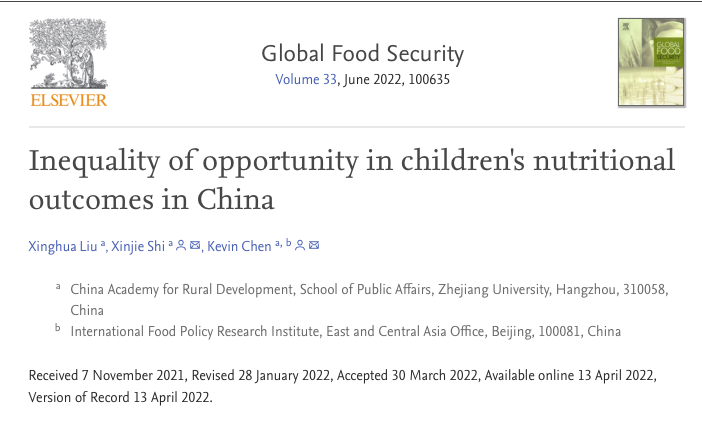近日,浙江大学求是讲席教授、国际食物政策研究所资深研究员陈志钢教授与刘星华博士后、史新杰研究员合作论文——Inequality of opportunity in children’s nutritional outcomes in China在全球食物安全领域著名期刊Global Food Security在线发表。Global Food Security为SCI 一区期刊,最新影响因子为7.772,在FOOD SCIENCE & TECHNOLOGY大类中排名为6/143。
Inequality of opportunity in children’s nutritional outcomes in China
Global Food Security
Xinghua Liu, Xinjie Shi, Kevin Chen
DOI:https://doi.org/10.1016/j.gfs.2022.100635

摘要:
在儿童营养差距中,既有个人的“努力”(选择)造成的不平等,又有外生“环境”因素造成的不平等,后者即为机会的不平等,需要进行修正。本文使用CHNS1989-2011,基于罗默的机会平等视角,研究了我国儿童营养表现中的不合理差距,即儿童营养的机会不平等。计算了低体重,生长迟缓,消瘦,超重和肥胖五个指标,以分别表示儿童营养不良和营养过剩状况。选取了儿童年龄、性别、户口、家庭人口数量、出生次序、家庭背景、地区和卫生条件等环境因素。在此基础上,运用参数估计法和方差分解法测算了我国0-15岁儿童营养状况的机会不平等程度。研究结果表明:(1)全样本分析中,生长发育迟缓的机会不平等相对系数最高,达到11.49%;(2)地区和家庭背景为贡献程度最高的两大环境因素;(3)分年龄样本结果表明6-10岁儿童面临的机会不平等程度高于0-5岁和10-15岁儿童;分地区样本结果表明,西部农村地区儿童面临的营养不良的机会不平等程度更高 ,而东部城市儿童则面临更大的营养过剩的机会不平等 。反事实分析结果进一步说明,如果农村儿童迁移到城市,全样本的机会不平等程度将上升19%, 表明在快速城市化进程中需要重视儿童营养的机会公平问题。最后提出缩小儿童营养机会不平等、促进营养公平的对策建议。
Abstract:
Using pooled data from the 1991–2011 waves of the China Health and Nutrition Survey (CHNS), this paper proposes an empirical study on inequality of opportunity in child nutritional outcomes. Children's nutritional outcomes were measured using anthropometric indicators including underweight, stunting, wasting, overweight and obesity. We examine the role played by circumstances beyond the control of individuals—for instance, children's age, gender, hukou status, household size, birth order, family background, region and sanitation—in generating nutritional outcomes inequality among Chinese children aged 0–15. We find that the largest relative share of inequality of opportunity (IOP) in child nutritional outcomes in China is 11.49% (stunting) for the entire sample. Shapley-value decompositions reveal that region and family background are the dominant contributors to inequality of opportunity for most of the nutritional outcomes. IOP turns out to be largest for the 6–10 age cohort. Heterogeneity analysis further shows that disadvantaged groups, for instance, children living in the rural area of western China, face higher unequal opportunities for undernutrition. Conversely, children from urban area of the east show a higher inequality of opportunity in overnutrition. In addition, our counterfactual analysis indicates that if those rural children had migrated to cities, the IOP for the full sample would increase by more than 19%, implying greater attention should be paid to equalizing opportunity amid massive migration and urbanization in China in the years to come.
